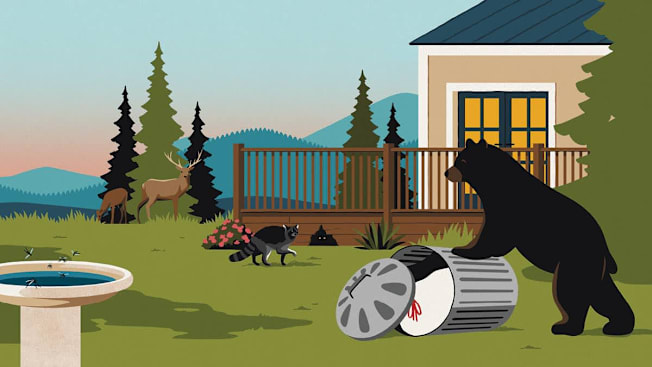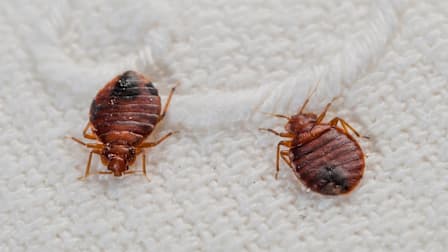How to Get Rid of Any Pest in Your Home or Yard—for Good
Wasps, mice, squirrels, ants, deer—these and other unwelcome critters can wreak havoc inside your house or yard, but you can prevent health risks and property damage by taking these smart steps
When you shop through retailer links on our site, we may earn affiliate commissions. 100% of the fees we collect are used to support our nonprofit mission. Learn more.

Who doesn’t love seeing beautiful creatures out in nature? The flick of a cardinal’s crimson wings, the delicacy of a dragonfly. But a mouse skittering across your kitchen floor? That’s a different story.
Animals and insects inside your home aren’t just a nuisance; they’re potential trouble, spreading pathogens and harming property. When can you manage the situation on your own and when do you need professional help? And what can you do to fortify your home—and yard—against unwanted visitors in the first place? Read on for smart, safe, effective solutions.
Insects
Protecting your house from insects starts outside. Richard Cooper, PhD, an entomologist and owner of R Cooper Consulting, a pest management firm in Yardley, Pa., says that ground cover, shrubs, and mulch encourage pest activity. So make sure they’re not touching your house’s foundation. They can be an express lane for bugs.
How to Get Rid of Ants
There are more than 700 species of ants in the U.S. Of those, 25 often come indoors, says Jim Fredericks, PhD, an entomologist and senior vice president of public affairs at the National Pest Management Association. Ants usually make their way inside in warm weather or after a heavy rain, searching for food and shelter.
How to Get Rid of Bees, Wasps, and Hornets
Outside your house, these insects do more good than harm, pollinating fruits, vegetables, and flowers. But it’s a problem when they nest on the exterior of a house, often under eaves and in walls. They can sting and occasionally do structural damage.
Get them out. Before you do anything, check insectidentification.org to find out which type of stinging insect you’re dealing with. Some of them (yellow jackets, killer bees, wasps) are aggressive and best left to pros. If you think it’s safe, use an insecticide spray (such as a wasp and hornet killer) on the nest at or after dusk, when hives are less active. These sprays can shoot a stream up to 20 feet into a nest, keeping you a safe distance away. But Roger Dickens, a wildlife expert and technical service manager for the national pest control company Terminix, says it’s hard to get a liquid spray into the back of a nest where it can reach the colony and kill off the population. The advantage to hiring a pro is that they can apply a powder form of insecticide, which the bugs will trail into the far recesses of the hive, and you won’t risk getting stung. It typically takes 24 to 48 hours to see results from applying insecticide.
Keep them out. Sealing your house is job No. 1. Make sure screens are intact and that windows and doors close tightly. In early spring, if you see a bee or wasp repeatedly buzzing around a specific area (say, near shutters), it’s likely a queen scoping out a nesting spot, so caulk any cracks and crevices. By the summer the insects have already made their nests or hives, so at that point the only recourse may be professional help (see pro services below).

Illustration: David Doran Illustration: David Doran
How to Get Rid of Moths
Adult pantry moths (aka Indian meal moths) and clothes moths live only a few weeks or months, but they can ruin kitchen staples and wreck sweaters, rugs, and more.
Get them out. With clothes moths, it’s not the adults that feed on fibers but the larvae. And the larvae are practically impossible to see, so you probably won’t know you have a problem until you notice mature moths fluttering around or find holes in your clothes. Dry-clean or wash potentially affected fabric items in hot water to kill the larvae and eggs, then store them in sealed bags. Freezing clothes in plastic bags for four days can also kill larvae and eggs. Large items like rugs will need a specialty dry cleaner.
Putting sticky moth traps in your closet will catch some adult bugs but might not eliminate the problem because larvae may already be hatching. Don’t use mothballs; they’re not effective, and their ingredients can irritate your eyes and nose. Extended exposure can even lead to liver and kidney damage.
Pantry moths typically enter your house via already infested dry foods (say, a box of cereal or bag of dog food) and fan out from there, say experts at the College of Agriculture and Life Sciences at Cornell University in New York. So if you spot tiny wormlike larvae or full-fledged moths in your cupboards, act fast. Inspect grain- and flour-based products (spread them out on a cookie sheet for easier examination) and dispose of anything that’s been affected. Then vacuum and wipe down cabinet surfaces.
Keep them out. Clothes moths can piggyback on used items you bring home, like a tag-sale blanket. Wash the items in hot water or freeze them before storing them with your things. To minimize pantry moth problems, keep dry goods in sealed containers.
How to Get Rid of Flies
House flies can carry 100-plus pathogens, including malaria, salmonella, and tuberculosis. Some research shows that fruit flies can transfer pathogens among their food sources.
Get them out. If you see just a few house flies, place flytraps or flypaper around your house. In tests of five brands of flytraps, a Texas A&M study found that Starbar Quikstrike products, like its Fly Bait, $27 for two, worked best. But for an infestation, it’s best to call in a pro to locate and treat the source.
Fruit flies feed on overripe produce, so toss old fruit and veggies, then set a trap near the trouble spot that consists of half an inch of apple cider vinegar and a couple of drops of dish soap in a small bowl. Cover with plastic wrap secured with a rubber band, and pierce the wrap a few times with a fork. Drawn to the vinegar, fruit flies will slip through the holes and get stuck. You can also buy fruit-fly traps, about $13 for a four-pack.
Keep them out. May we repeat: Seal your house well. And keep rodents out. A dead mouse in a wall could lead to a sudden flurry of "blow" flies (the kind with a blue-green sheen). To prevent fruit flies, rinse and dry produce as soon as you bring it home (even bananas and citrus). Though invisible to us, a cache of fruit fly eggs lurking on fruit can be 500 strong, so don’t leave a bowl of fruit on the counter. Either refrigerate fruit (24 hours in the fridge can kill eggs) or keep it in a sealed container. If you don’t compost or use a garbage disposal, store fruit rinds in a zipped plastic bag in the freezer until trash day to keep the kitchen bin free of fruit flies.
How to Get Rid of Roaches
For some 140 million years, roaches have roamed the planet. "They move around dirty surfaces and can contaminate food and trigger allergies," says Changlu Wang, PhD, an extension specialist in the department of entomology at Rutgers University.
Get them out. Roaches love kitchens (for the food) and bathrooms (for the dampness). If you see just a few, suck them up with a bagged vacuum and throw out the bag with the trash right away, Wang says. (The same advice applies to stink bugs, ladybugs, and crickets, which head indoors in cool weather—although you could scoop them up and take them outside; all are considered beneficial.) If you’ve seen one roach, there may be more. Wang recommends placing gel bait under the stove, refrigerator, and sinks.
Keep them out. Gel baits—and maintaining a clean, well-sealed house—are your best defense. For an ongoing problem, call an exterminator.
How to Get Rid of Termites, Carpenter Ants, and Carpenter Bees
Termites, carpenter ants, and carpenter bees can eat or burrow into wood components of a house—the foundation, beams, or joists—and cause structural problems, not to mention aesthetic ones. Termites alone cause $5 billion in property damage per year in the U.S.
Matt Frye, a rodent and structural pest management specialist at the New York State Integrated Pest Management Program at Cornell University, suggests doing a walk-through of your house’s interior at least annually to check for signs of these types of pests. Be especially alert in high-moisture zones like the basement. Signs of termites include pencil-sized mud tubes along a foundation wall or hanging under floor joists, as well as discarded wings near windows and doors. With carpenter bees, you’ll see what’s known as frass, a mix of chewed-up wood and insect pieces, says Roger Dickens of Terminix. Carpenter ants are primarily nocturnal. Flick on a light at night and you might see them scurry.
If you find evidence of these pests, don’t buy a DIY treatment. Instead, call a pro who’s licensed by the National Pest Management Association.

Illustration: David Doran Illustration: David Doran
Rodents and Other Small Critters
Summer is a great time to close gaps and cracks before rodents seek shelter indoors in the fall, Frye says. It’s estimated that they infiltrate about 21 million U.S. homes every winter.
How to Get Rid of Mice
These critters can squeeze through tight spaces, climb to reach holes in a roof, and chomp through drywall, insulation, and wires, potentially sparking fires. According to the Centers for Disease Control and Prevention, they also contaminate food and can carry salmonella and hantavirus, which can be fatal to humans.
Get them out. A classic snap trap is fast and reusable. Newer no-see/no-touch traps, which have a snap mechanism inside a closed box, can spare you some unpleasantness, but they aren’t reusable. Bait stations are another choice. Rodents die a couple of days after eating the bait—but this could happen inside your walls, leaving you with another (smelly) problem. If you’d rather not kill mice, you can use a "catch and release" trap baited with peanut butter (which rodents prefer to cheese), then free them far from home. There’s another option many people swear by: Get a cat.
Keep them out. Mice can get through even a dime-sized hole, so seal cracks with caulk and fill larger gaps near baseboards, doors, and windows with steel wool, which mice tend not to chew because of its sharp edges. Keep food, including pet food, in airtight containers, and sweep regularly. You can also hire an exterminator to find and close up entry points and/or use rodenticides only available to pros. You might see sonic devices that manufacturers claim emit sound waves (inaudible to us) that deter critters. While they may be helpful, more research is needed.
How to Deal With Squirrels and Possums
They may not get inside as frequently as mice, but these creatures can wreak havoc when they do. Squirrels can chew through electrical wires and carry rabies, fleas, and ticks. Possums cause damage by scratching and gnawing, and can carry toxoplasmosis and tuberculosis, which can be transmitted through bites.
Get them out. It’s best to close off the area where they are until you can get help from a wildlife pro, especially if the animals are in a hard-to-reach spot. According to Angi, removal services can range from $250 to $500. If there’s just one critter in an area with an exterior door, you could try to shoo it out with a broom. But don’t get too close—it might bite.
Keep them out. Squirrels can get onto a roof from nearby trees, so cut branches 6 to 8 feet back from your home. Place hardware cloth (a heavy-gauge mesh) of half an inch or larger over vents, cap the chimney with an animal guard, and seal cracks around windows and doors. For louvered attic openings, use window screening inside, then cover that with hardware cloth.
Bats, Birds, and Snakes
These animals often pop up in horror movies, which means no one wants to encounter them inside. While there are a few ways to protect your house and potentially shoo away these pests, in many cases you’ll need to call a professional.
How to Deal With Bats
Bats are a misunderstood species, playing a vital role in pest control, plant pollination, and seed dispersal. Still, they can carry pathogens (it’s rare, but humans can contract rabies from a bite) and leave heaps of harmful poop, or guano.
Get them out. If there’s a lone bat lost in your house, turn off interior lights, open the windows, and turn on an exterior light to encourage it to exit. (Bats eat bugs, which are drawn to light.) But if you have several bats living in, say, your attic, call a licensed wildlife professional. They’re protected in certain regions, so they need special handling.
Keep them out. Install screens over vents, cover chimneys with animal guards, fill obvious holes with steel wool, and caulk cracks. Bats can slip into spaces as small as ⅜ inch wide. But wait until the weather cools: April through August is breeding season, and sealing off areas could trap babies.
How to Deal With Birds
Gutters, soffits, and eaves offer convenient nesting sites, but birds settling into these spots can clog drainage and ventilation paths, as well as leave acidic droppings.
Get them out. You’ll probably have to wait until late summer. Most active nests are protected under the Migratory Bird Treaty Act. Once you confirm that a nest is inactive, cover yourself up in long pants and a long-sleeved shirt, and put on rubber gloves and a mask because bird droppings can transmit diseases such as histoplasmosis (a fungal lung infection). Dispose of the nest in a zip-top bag; double bag it for safety. Scrub away bird droppings with a solution of 1 part bleach to 10 parts water. If you need help—or if you discover a nest during breeding season in a hard-to-reach place like a chimney—call a pro.
Keep them out. Protect enticing outdoor spots. Use a metal guard on the dryer vent and place mesh covering over gutters. If birds are drawn to the corners of window sills, deter them by installing metal bird spikes, which usually attach to the sill with screws or construction adhesive.
How to Deal With Snakes
Snakes can get washed inside by flood waters or slither into dark cellars for shelter or food, then stay to hibernate.
Get them out. If you’re absolutely sure a snake is harmless (go to cdc.gov/niosh and search for "snakes"), you could put on gloves, grab it, and toss it into the yard, or buy a snake trap. But it’s generally safer to call a pro.
Keep them out. Seal holes exceeding ¼ inch in diameter in a basement or crawl space, and replace missing door sweeps and vent covers. Minimize scrap heaps and woodpiles near your house. You can also buy snake repellents, but read the warning labels carefully.

Illustration: David Doran Illustration: David Doran
Other Backyard Pests
Critters both large and tiny that enter your yard can cause a variety of problems. Here’s how to address them.
Mosquitoes and Ticks
"The deadliest creature in the world isn’t a shark, snake, or spider," says Jim Fredericks of the National Pest Management Association. It’s the mosquito, which can spread diseases including malaria, yellow fever, dengue, encephalitis, West Nile virus, and Zika virus. Mosquitoes are attracted to standing water and need only half an inch of it to lay eggs, Fredericks says, so eliminate pools in flower saucers and clogged gutters. Plant basil, catnip, marigold, mint, lavender, or lemon balm; their scent may help repel mosquitoes.
Ticks, which can carry Lyme disease, tend to live in dense landscaping, tall grass, and wooded areas. Mow often and thin out dense plantings. Patio furniture, play sets, and a dog’s invisible fence all need a 6-foot buffer of manicured, unused lawn from woods or meadows that abut your property, says Richard Cooper, an entomologist. Ticks can travel inside on pets (even those treated with protective meds), so inspect them after they’ve been outside. Having a pro spray your perimeter and in wooded areas can help. Wear long sleeves, and tuck pants into socks for longer outdoor stints. Our top-rated insect repellents also guard against ticks.
To protect yourself against bites, cover up and use a repellent. Consult our buying guide for helpful guidance on ingredients and how to apply repellents. Those that contain deet, like our product picks below, do well in our ratings.
Raccoons and Skunks
These creatures look for a cozy spot to make a den. They can damage property, carry disease, and, in the case of skunks, spray a noxious odor. To ward them off, keep your yard free of debris and block spaces under porches and decks. You might need to hire a pro to cover open areas with hardware cloth or wire mesh, which should extend 2 inches down into the soil (these animals can dig). Make your property less appealing by placing open jars of vinegar or ammonia-soaked rags (natural deterrents) near areas you want to protect. Wear a mask and gloves when handling these materials. If you have pets, don’t use ammonia; it can be toxic. Opt for vinegar instead.
Deer, Bears, and Coyotes
Deer can transport ticks and eat up your garden; coyotes and bears can tear into trash and threaten pets. To avoid attracting them, thoroughly clean your grill and even clear away fruit that has fallen off trees. Find certified bear-proof trash containers at bearwise.org; these can also stop coyotes. If you see a bear or coyote loitering, stay inside, turn on outdoor lights, and make loud noises to scare them off. Deer like to eat hostas, coleus, hydrangeas, and vegetables, but they avoid strongly scented and flavored plants like herbs, geraniums, and alliums, so try planting these nearby. A deer fence (which should be at least 76 inches high) can cost $17 to $90 per linear foot.
Call the Right Pro
The right expert can make quick work of a pest problem. Here’s what to know.
Exterminators
These pros can identify and eliminate insects and rodents by using chemicals. To find one, go to pestworld.org; check your state’s pest regulatory agency (often the state Department of Agriculture); or check the Better Business Bureau. Angi and HomeAdvisor can also offer leads. Angi says pest-control treatments run about $170. If you have pets, ask in advance about safety protocols.
Wildlife Control Professionals
These experts are trained to handle most small critters, including squirrels, bats, skunks, and snakes. Search the Find a Pest Pro section at pestworld.org; use a specialized directory, like the one at batworld.org; or find local licensed practitioners on Angi or HomeAdvisor. Companies such as Critter Control operate nationally. A wildlife-removal visit costs about $400, according to Angi. If an animal is endangering public safety, contact your municipality’s animal control department or your state’s wildlife agency.
Yard-Spraying Services
These companies might be listed as exterminators and can be found through similar directories. Call them for problems with ticks, fleas, and mosquitoes. Some offer termite treatments, too. You may see familiar names such as Lawn Doctor, Mosquito Squad, Orkin, Terminix, and TruGreen. One mosquito treatment is around $250, but cost depends on the size of the property and the severity of the problem. Termite treatment ranges from about $240 to $1,000. Nest removal for bees, wasps, or hornets is typically around $525. Some companies advertise natural spraying services, but their products may have a "shorter efficacy period than synthetic products," says Matt Frye, a rodent specialist at Cornell University. It’s a good idea to ask the company you’re considering how long it expects the treatment to last.
Fix-It People
They can fill cracks, add weather stripping, repair screens, and put up fencing or mesh to keep pests out of crawl spaces. Search on Angi, HomeAdvisor, and Taskrabbit, and read reviews to make sure the person you choose has the skills you need. Angi says you can expect to pay $50 to $150 per hour for this kind of service.
Editor’s Note: This article also appeared in the July/August 2025 issue of Consumer Reports magazine.




















